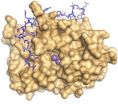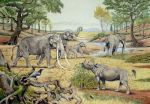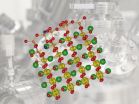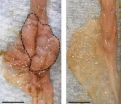(Press-News.org) The surface of the sea takes up nitrogen oxides that build up in polluted air at night, new measurements on the coast of southern California have shown. The ocean removes about 15 percent of these chemicals overnight along the coast, a team of atmospheric chemists reports in the early online edition of the Proceedings of the National Academy of Sciences the week of March 3.
Nitrogen oxides, formed by the burning of fossil fuels, generate photochemical smog. Atmospheric chemists would like to account for the fates of these molecules in a kind of budget that indentifies their sources and sinks – ways in which they are removed from the air.
"One often neglected path is reaction at the surface of the sea," said Tim Bertram, an assistant professor of chemistry at the University of California, San Diego, who led the research. "The sea has a salty, rich, organic surface with the potential for a variety of chemical reactions."
To track the cycle of nitrogen in the atmosphere, they studied dinitrogen pentoxide, a molecule that results from the oxidation of nitrogen oxides. It can react with chloride from sea salt, for example, to form nitryl chloride. When sunlight hits nitryl chloride the next morning, it regenerates nitrogen oxides and frees a chlorine radical that attacks other molecules in reactions that can lead to the formation of ozone.
Michelle Kim, a graduate student at UC San Diego's Scripps Institution of Oceanography working with Bertram, deployed intruments at the end of the institute's pier in La Jolla, Calif., to measure the flux of these molecules.
On the night of February 20, 2013, the usual offshore breeze reversed to provide the pure ocean fetch needed to measure the exchange between air and sea. The airmass she measured also contained emissions from Los Angeles that had blown out to sea. That gave Kim an opportunity to measure the fates of dinitrogen pentoxide and its product, nitryl chloride, over the course of a night.
By simultaneously measuring concentrations of both molecules and turbulence in the air above the sea surface, Kim saw a net movement of dinitrogen pentoxide into the ocean, but was surprised to see no net exit of nitryl chloride into the air.
"We knew from previous work that nitrogen oxides are lost to various surfaces – sea spray and other aerosols, even snowpack," she said. "This study shows – for the first time - that the ocean is a terminal sink for nocturnal nitrogen oxides, and not a source for nitryl chloride under these sampling conditions."
These observations haven't been made before in large part because the measurements use a micrometeorological technique to answer an atmospheric chemistry question. Co-author Delphine Farmer at Colorado State University, a leader in these methods, helped to guide to the flux measurements.
Betram says it's part of his group's mission, to "embrace the complexity to study real systems in their native states and the coupling of the natural world with our influence."
INFORMATION:
The National Science Foundation supported this work.
The surface of the sea is a sink for nitrogen oxides at night
2014-03-03
ELSE PRESS RELEASES FROM THIS DATE:
Amazon's canopy chemistry is a patchwork quilt
2014-03-03
Washington, D.C.— In many ways, plants act as chemical factories, using energy from sunlight to produce carbon-based energy and taking nutrients from the soil in order to synthesize a wide variety of products. Carnegie scientists asked the question: How much does the portfolio of chemicals generated by plants vary, depending on the surrounding environment, and what can this tell us about how we interact with forests? The answer involved climbing into the Amazonian canopy, resulting in the discovery that the forest's chemical portfolios form a rich mosaic that varies with ...
We want to save water, but do we know how?
2014-03-03
BLOOMINGTON, Ind. -- Many Americans are confused about the best ways to conserve water and have a slippery grasp on how much water different activities use, according to a national online survey conducted by an Indiana University researcher.
Experts say the best strategy for conserving water is to focus on efficiency improvements such as replacing toilets and retrofitting washing machines. However, the largest group of the participants, nearly 43 percent, cited taking shorter showers, which does save water but may not be the most effective action. Very few participants ...
Experimental stroke drug also shows promise for people with Lou Gehrig's disease
2014-03-03
Keck School of Medicine of USC neuroscientists have unlocked a piece of the puzzle in the fight against Lou Gehrig's disease, a debilitating neurological disorder that robs people of their motor skills. Their findings appear in the March 3, 2014, online edition of the Proceedings of the National Academy of Sciences of the United States of America, the official scientific journal of the U.S. National Academy of Sciences.
"We know that both people and transgenic rodents afflicted with this disease develop spontaneous breakdown of the blood-spinal cord barrier, but how these ...
Big stride in understanding PP1, the ubiquitous enzyme
2014-03-03
PROVIDENCE, R.I. [Brown University] — In the Proceedings of the National Academy of Sciences, a team of scientists at Brown University reports a major step forward in determining the specific behavior of the ubiquitous enzyme PP1 implicated in a wide range of diseases including cancer.
PP1, whose role is to enable the passage of molecular messages among cells, is found pretty much everywhere in the body. Its wide range of responsibilities means it is essential to many healthy functions and, when things go wrong, to diseases. But its very versatility has prevented it from ...
Mount Sinai study points to new biological mechanisms, treatment paradigm for kidney disease
2014-03-03
New York, NY – Prevention and reversal of chronic kidney disease is an urgent public health need. The disease affects 1 in 10 Americans, is debilitating and deadly, and existing drugs, at best, offer only mild delay in progression to end-stage kidney failure. New research led by Icahn School of Medicine at Mount Sinai investigators has uncovered abnormal molecular signaling pathways from disease initiation to irreversible kidney damage, kidney failure, and death. Results from their preclinical and human research are published online March 3 in the Journal of Clinical Investigation.
"Our ...
Researchers identify 'carbohydrates in a coal mine' for cancer detection
2014-03-03
Researchers at New York University and the University of Texas at Austin have discovered that carbohydrates serve as identifiers for cancer cells. Their findings, which appear in the journal Proceedings of the National Academy of Sciences, show how these molecules may serve as signals for cancer and explain what's going on inside these cells, pointing to new ways in which sugars function as a looking glass into the workings of their underlying structures.
"Carbohydrates can tell us a lot about what's going on inside of a cell, so they are potentially good markers for ...
New discovery solves problem of anti-inflammatory substance
2014-03-03
There have been great expectations regarding the production of a drug to block the enzyme LTA4 hydrolase, which plays a key role in the body's inflammatory response. However, in clinical trials, such molecules have proven to be only moderately effective. Now, researchers at Karolinska Institutet have successfully refined their understanding of why previous substances have been less effective – and in so doing have produced a molecule that gets around the problem. Consequently, there is once again hope of a new anti-inflammatory drug based on the principal of blocking LTA4 ...
Large mammals were the architects in prehistoric ecosystems
2014-03-03
Researchers from Denmark demonstrate in a study that the large grazers and browsers of the past created a mosaic of varied landscapes consisting of closed and semi-closed forests and parkland. The study will be published on Monday 3 March 2014 in the renowned journal PNAS (Proceedings of the National Academy of Sciences of the United States of America).
Dung beetles recount the nature of the past
The biologists behind the new research findings synthesized decades of studies on fossil beetles, focusing on beetles associated with the dung of large animals in the past ...
Electronics based on a 2-D electron gas
2014-03-03
Usually, microelectronic devices are made of silicon or similar semiconductors. Recently, the electronic properties of metal oxides have become quite interesting. These materials are more complex, yet offer a broader range of possibilities to tune their properties. An important breakthrough has now been achieved at the Vienna University of Technology: a two dimensional electron gas was created in strontium titanate. In a thin layer just below the surface electrons can move freely and occupy different quantum states.
Strontium titanate is not only a potential future alternative ...
Gut microbes spur development of bowel cancer
2014-03-03
It is not only genetics that predispose to bowel cancer; microbes living in the gut help drive the development of intestinal tumors, according to new research in mice published in the March issue of The Journal of Experimental Medicine.
Bowel cancer, also called colorectal cancer, results from a series of genetic changes (mutations) that cause healthy cells to become progressively cancerous, first forming early tumors called polyps that can eventually become malignant. Although mutations can occur anywhere in the human intestine, certain types of colorectal cancer tend ...







